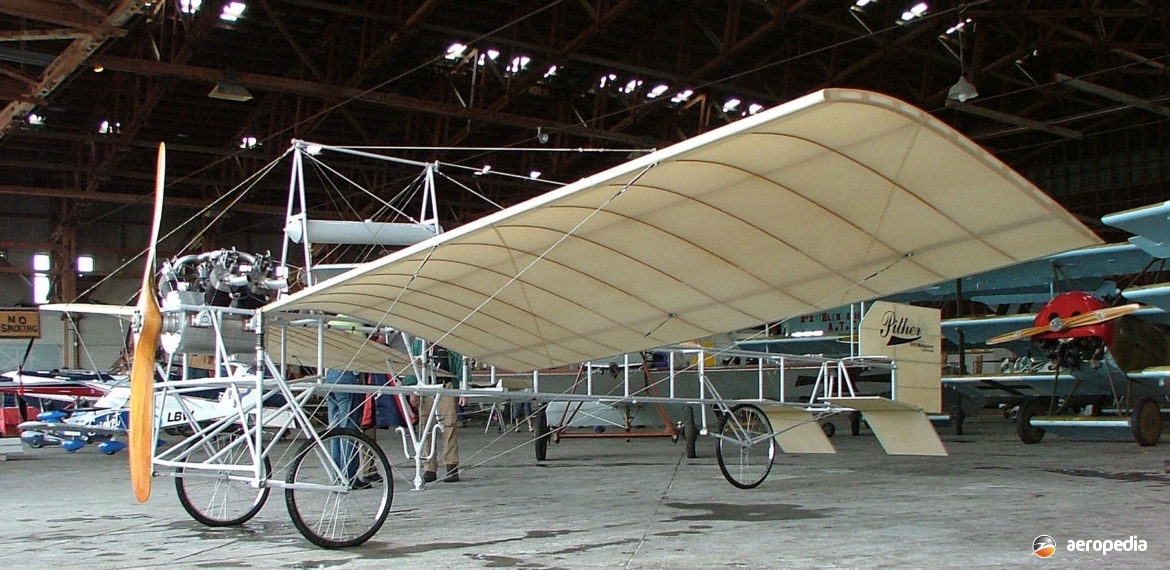Photograph:
The Pither monoplane replica ZK-JAH (c/n 1) at Omaka, New Zealand in March 2005 (David C Eyre)
Country of origin:
New Zealand
Description:
Single-seat light monoplane
Power Plant:
One 30 kw (40 hp) four-cylinder VEE air-cooled engine. Thrust capability 113 kg (250 lb).
Specifications:
- Wingspan: 8.5 m (28 ft)
- Length: 7.9 m (26 ft)
- Wing area: 14.9 m² (160 sq ft)
- Weight excluding the pilot: 230 kg (500 lb)
History:
Herbert John Pither [1871 to 1934] was born in Reigate, Surrey, in the United Kingdom and was the second eldest of 12 children of John and Lydia Pither, who emigrated to Canterbury on the south island of New Zealand on board the vessel ‘Crusader’ in 1875. Known for his interest in the manufacture of anything weird and mechanical, Pither was a professional cyclist and bicycle manufacturer, and ran an engineering business in Kelvin Street, Invercargill in the period 1906 – 1910. He was also very much interested in aviation.
He built the structure of an aeroplane along Bleriot-style principles using steel tubing used in the manufacture of cycles, it being built of box-girder theory with wooden ribs and with fabric covering. Control in the air was by pedal-operated tail rudder; lateral stability was achieved by warping the rear edges of the wings, controlled by a steering wheel; the pitch control was by lever-operated elevators; and the undercarriage was motorcycle or bicycle wheels with spring shock absorbers. At the time he built petrol driven engines for boats and agricultural machinery, and built a V-4 air-cooled engine for the aircraft. In 1902 he built a motor car in Christchurch.
It is claimed Bert Pither made a flight on 5 July 1910 from what was known as Riverton Beach in New Zealand’s southland but there is no contemporary record of a witness to the flight which Pither later described. The flight has never been recognised as the first successful flight in New Zealand. It is said the aircraft flew at a height of 7.6 m (25 ft) to 9.1 m (30 ft) for some distance. Certainly photographs were taken of the aircraft at the time, and articles appeared in the Southland News Journalist and the Otago Witness in July 1910. It seems Pither only made one flight in the machine and after the ‘flight’ took the aircraft to Australia in November 1910 hoping to interest the Australian Government in the machine but he, and the aircraft, then seem to have disappeared from the aviation world. An engine, said to be that built by Pither, is in the collection of the MOTAT Museum in Auckland but it in later years was considered to be an engine built by James Paskell, an Invercargill aviation experimenter and scrap-metal merchant, and was retrieved from a well where it had been dumped.
Critiques over the years have disclaimed the ability of Pither’s aircraft to fly and in 2004 Colin Smith of the Croydon Aircraft Co at Mandeville decided to build a replica to see if it could fly. An engineer from Waikaka, Bill Sutherland, built an engine for the aircraft which was of V-4 configuration similar in appearance to the Pither engine using Cirrus engine cylinders, the engine/propeller combination providing 113 kg (25 lb) of power.
This replica was completed in early 2005 and on 18 February that year, with Jerry Chisum at the controls, the replica was flown at the airstrip at Mandeville for 100 metres (328 ft) at a speed of 70 km/h (43 mph) on 18 February 2005. A number of flights were made. To build the replica working drawings were made from photographs taken at the time and from specifications appearing in newspaper reports. The construction team was confident they had built as authentic a replica as possible.
This flight, and others, proved the original aircraft could have flown and many asked why Pither did not persist with his experiments, the test pilot of the replica indicating the machine was airworthy and controllable. Certainly the fact the replica flew increased the probability that Pither flew. Pither married an Australian, Sarah Hahir, and moved to Australia where he eventually died.
At Easter 2005 the replica was taken to Omaka aerodrome at Blenheim where it was demonstrated, making a short flight down the runway, before returning to Mandeville where it has been placed in a museum to honour the inventive Bert Pither for his achievements. On 13 January 2015 the replica was placed on the New Zealand civil aircraft register as ZK-JAH (c/n 1) to the Croydon Aircraft Company of Gore. The aircraft has been taken to other events.
The flights of the replica have again put into question as to who was the first person to make a powered flight in New Zealand, which has always been recorded as being Vivian Walsh at Papakura in February 1911 in a Howard Wright biplane “Manurewa No 1”.

